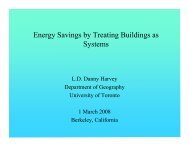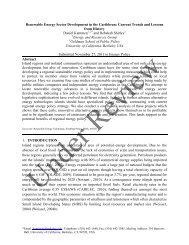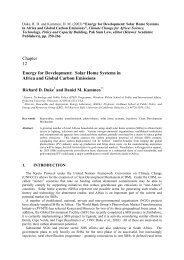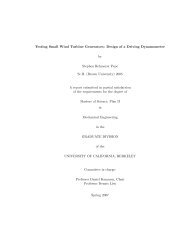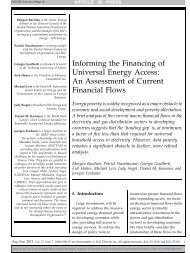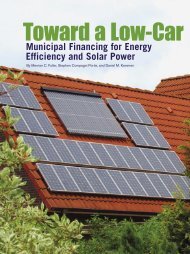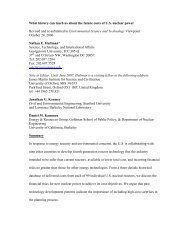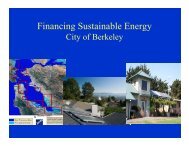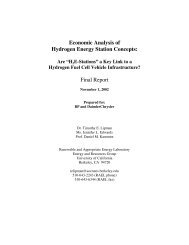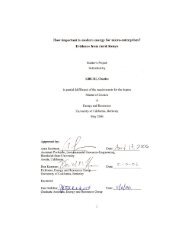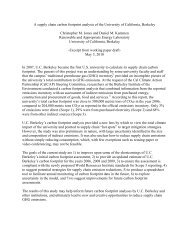Innovations, Energy for Change, Fall 2009.pdf - Renewable and ...
Innovations, Energy for Change, Fall 2009.pdf - Renewable and ...
Innovations, Energy for Change, Fall 2009.pdf - Renewable and ...
Create successful ePaper yourself
Turn your PDF publications into a flip-book with our unique Google optimized e-Paper software.
Vinod Khosla<br />
tion targets <strong>and</strong> estimations of how quickly the world’s GDP carbon efficiency<br />
must grow to meet those targets. 1 This approach is significantly easier <strong>for</strong> the<br />
developing world than many others that have been suggested, <strong>and</strong> should be more<br />
politically palatable. It does not ask them to slow their growth, but rather to<br />
improve the efficiency of that growth, especially in conjunction with flows of<br />
CDM (Clean Development Mechanism) funding. From a fairness st<strong>and</strong>point, it<br />
does not unduly punish nations <strong>for</strong> their rates of growth, but rather aligns incentives<br />
so that efficiency <strong>and</strong> growth become common goals.<br />
If we accept that increasing carbon efficiency is the key, the next question is<br />
where <strong>and</strong> how the developing nations can work towards this goal <strong>and</strong> how the<br />
CDM mechanism can be used to guide it. I believe that access to cheap capital (<strong>and</strong><br />
thus lower financing costs) is vital; in fact the cost of capital may be the most critical<br />
tool in developing a lower carbon GDP economy. Developing nations may be<br />
able to lower the cost of capital by leveraging relatively low-interest loans to invest<br />
in low-carbon power generation, be it electricity or biofuels. In the rest of this article<br />
I describe these ideas <strong>and</strong> show how they might work in combination.<br />
CONSIDERING METRICS<br />
John Holdren, director of the White House Office of Science <strong>and</strong> Technology<br />
Policy, summarized the current situation in a recent talk:<br />
We have a global climatic disruption <strong>and</strong> serious harm is already occurring.<br />
Mitigation, adaption <strong>and</strong> suffering are our only options <strong>and</strong> the<br />
more we have of the <strong>for</strong>mer two, the less we will have of the latter. The<br />
key question is whether we can we avoid catastrophic interference. 2<br />
In light of the current situation, it is clear that mitigation must happen everywhere<br />
to make a material difference. But how should the burden of mitigation be allocated?<br />
The proposals so far have been dominated by Western points of view <strong>and</strong><br />
mostly consist of tradeoffs between the various Western constituencies including<br />
business, labor, agricultural <strong>and</strong> environmental groups. The proposals don’t work<br />
with the priorities of many developing countries like India <strong>and</strong> China, which have<br />
mostly distanced themselves from the discussions. Is it possible to craft a set of<br />
proposals that are more likely to be acceptable to this constituency?<br />
The first step toward responding to these questions is reviewing emissions <strong>and</strong><br />
economic data. Figures 1 <strong>and</strong> 2 show (1) total annual CO 2 emissions by country,<br />
<strong>and</strong> (2) CO 2 emissions per capita, by country, color-coded by GDP per capita on a<br />
PPP basis. 3 Discussions in the West turn almost exclusively to one idea: reducing<br />
carbon in percentage terms from the 1990 level. While this is in line with scientific<br />
recommendations as a global target, reviewing the charts below raises further<br />
questions on how to allocate this goal among all nations. Examining Figure 1, is it<br />
reasonable to compare the cumulative emissions of two countries, one with a billion<br />
people <strong>and</strong> one with a million? Reviewing Figure 2, is it reasonable to ask a<br />
country whose per-capita income is $1,000 to meet the same percentage carbon<br />
24 innovations / fall 2009



